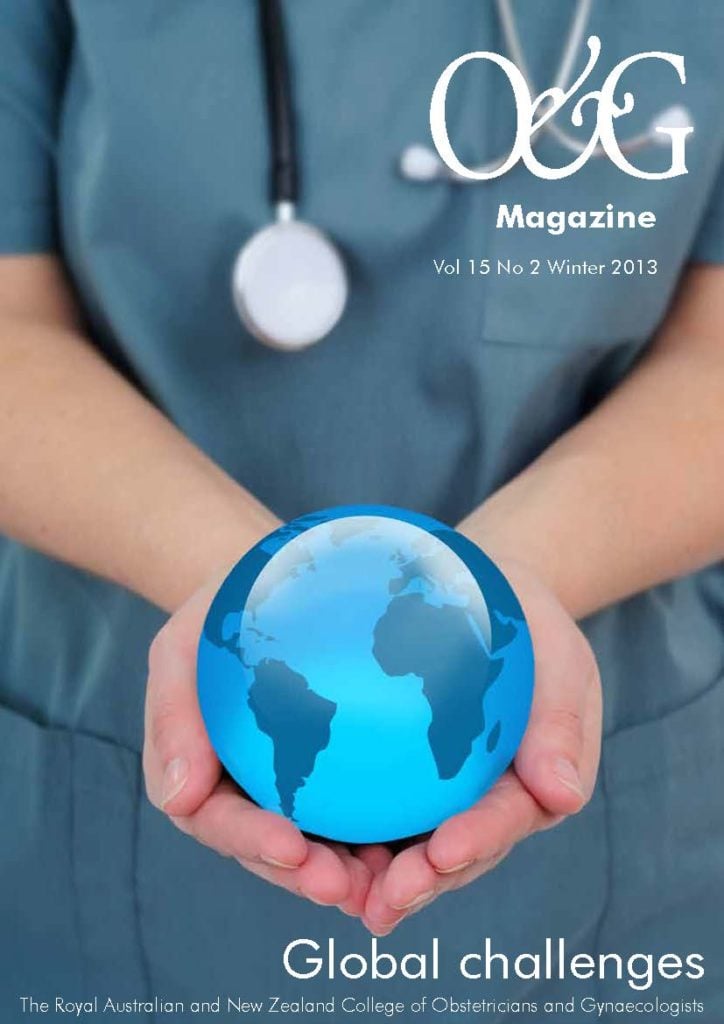Overcoming the logistical barriers to the provision of contraception is having many beneficial knock-on effects, including preventing maternal mortality.
Papua New Guinea (PNG) is one of Australia’s nearest neighbours and yet has one of the highest reported rates of maternal mortality in the world. It is sobering to realise that within a couple of hours’ flying time from Australia there is a country with a maternal mortality rate of over 700:100 0001 (Australia is about 8:100 000).
There is an enormous unmet need for contraception in the developing world. The provision of reliable contraception is one of the most cost-effective means of reducing maternal mortality. It also provides a range of other community and social benefits (for example, improved educational opportunities for adolescent girls and women as well as reduced reliance on unsafe abortion practices). It is estimated that maternal mortality in the developing world could be reduced by about 30 per cent by widespread availability of reliable contraception.2,3
The Trobriand Islands
In 2012, I became involved in establishing a project to initiate the provision of contraception in a remote group of islands in the Milne Bay Province of PNG. The Trobriand Islands are located off the eastern tip of PNG in the Solomon Sea. The population was extensively studied by the anthropologist Molinowski and was the subject of his book Sex and Repression in Savage Society.4 The Trobriands have since often been referred to as the ‘islands of love’, based on their sexual customs and free love traditions. Interestingly, they were the basis of the sexual morality in the Aldous Huxley novel Brave New World. It is perhaps little wonder that contraception has eventually become an issue of major importance.
The vast majority of the population inhabit Kiriwina Island, which is the largest isle of the Trobriand Island group. Data from a recent PNG census indicates that the population of Kiriwina Island is in excess of 50 000 people. To put some context on this, the population was said to be stable at around 10–12 000 since the early part of last century. It is not clear why this increase has occurred. Nevertheless, this population explosion is having a dramatic effect on life on the island, with issues such as food supply and disputes over land becoming serious problems.
Kiriwina Island has one hospital and one doctor (externally funded). He commenced work there in 2011 (for the previous 20 years there was no doctor). The hospital’s electricity supply is by diesel generator for a few hours a day and is unreliable; there is usually running water in parts of the hospital. There is, however, excellent mobile phone coverage across the vast majority of the island.
There is no reliable supply of contraception. Depo-Provera, the oral contraceptive pill (OCP) and condoms are on offer through the outpatient clinic at the hospital, but are frequently out of supply. Access to the hospital is also an issue as many villages on the island are quite remote from the hospital and, of course, as far as the surrounding islands are concerned it is even more problematic.
Marie Stopes had recently established a family planning clinic in the Highlands in PNG and were reporting good success with contraceptive implants, although the overall numbers were quite small. After some consideration we decided that implants would be the best option for our mission. We used the Sino-implant (II). This is the option being promoted by the Bill and Melinda Gates Foundation-funded global contraception initiative, and these Chinese-manufactured implants have been used safely and effectively in many developing countries around the world.5 The Sino-implant (II) is a two-rod subdermal implant system that releases 150mg of levonorgestrel. It is effective for between four and five years and is currently about half the cost of Implanon.
Operation contraception
In preparation for our project, the doctor from Kiriwina and a local midwife visited the Marie Stopes clinic in the PNG Highlands for implant training. An extensive community contraception education campaign was mounted across Kiriwina Island. Our plan was to conduct a one-week contraception blitz (and at the same time perhaps scope other health-improvement opportunities) to create momentum and then have the local staff provide ongoing service. Our project manager, Wendy Stein OAM, was a key factor in the success of this mission. She had visited Kiriwina Island many times, was instrumental in the appointment of a doctor to the island and was the initiator, organiser and driving force behind the mission.
This was my first occasion working in a remote, resource-poor setting and both individually and as a team we faced many challenges. We worked in close collaboration with our colleagues from Kiriwina Island. Marie Stopes had kindly provided us with 500 implants. Women arrived in droves, on foot, by boat and quite literally by the truck load. We ordered an urgent air freight consignment of more implants that unfortunately did not arrive – they were off loaded at the preceding airport to make way for a coffin, but that’s another story. We ran out of implants with one day of our mission remaining. However, the local doctor and midwife were now experts in implant insertion and we had set the contraceptive ball rolling.
By the time we returned, six months later, the implant tally was well over 1000 (by rough calculation that’s about ten maternal deaths prevented). Again, we established very clear goals prior to the mission: follow-up and evaluation of the implant users; train and accredit more local staff; and conduct some outreach implant insertion clinics for the hard-to-access areas.
By the end of our second one-week stay we had educated, trained and formally accredited 14 additional local staff for implant counselling and insertion (there are two staff with excellent expertise in implant removal); inserted a further 500 implants and conducted evaluations on over 200 women whose implants had been in situ for four to six months; and conducted some valuable outreach clinics.
Outcomes
Evaluations were completed for 225 women. Their average age was 28.7 years with an average duration of implant use of 4.4 months (range 3–7 months). Mean parity was 3.4, including 18 nulliparous women and 72 women with five or more children. The satisfaction rate was 92.4 per cent (208/225). Nine women had an undiagnosed early pregnancy at the time of implant insertion and these implants were removed. Only two women requested implant removal because of side effects. Excluding the pre-existing pregnancies, that is a continuation rate of 99 per cent.
These data provide very strong support for the ongoing roll out of implantable contraception in PNG. The report from our mission, including the evaluation summary, was circulated to local and national health authorities in PNG. Within weeks there was enthusiastic interest in running similar programs at other sites in PNG. Based on the model we employed on Kiriwina Island, our project manager Wendy has now established numerous other clinics across the Milne Bay Province, with the staff we trained becoming the trainers for the new clinics. It is just over 12 months since our first mission and so far more than 3500 implants have been inserted. A further 16 health workers have been trained/accredited and 11 health centres now have trained staff and are stocked with implants, including Alotau Hospital (the major hospital in the province). The program continues to expand and, to date, there have been a number of other firm enquiries from health centres outside the Milne Bay Province in PNG wishing to establish similar programs.
More than 700 people attended a recent community education session on contraception in a remote area. Women and their partners want safe reliable contraception. It saves lives and has the capacity to change communities.
Acknowledgements
This project would not have been possible without the support of Rotary (RAWCS), Marie Stopes, DAK Foundation and of course the two fantastic teams of volunteers who gave freely of their time and expertise. Prof Glen Mola and Dr Miriam O’Connor also provided invaluable advice and support. I would like to dedicate this article to Lucy who passed away from HIV-related illness shortly after our second mission. She was a tireless helper. Her dedication, sharp intellect and dry wit was an inspiration to us all. She is survived by her four-year-old daughter Bernadette.
References
- Sanga K, de Costa C and Mola G. A review of maternal deaths at Goroka General Hospital, Papua New Guinea 2005–2008. ANZJOG. 2010; 50: 21–24.
- Sonfield A et al., The Social and Economic Benefits of Women’s Ability to Determine Whether and When to Have Children, New York: Guttmacher Institute, 2013, www.guttmacher.org/pubs/social-economic-benefits.pdf.
- Saifuddin Ahmed, Qingfeng Li, Li Liu, Amy O Tsui. Maternal deaths averted by contraceptive use: an analysis of 172 countries. Lancet. 2012;380:111-25.
- Malinowski, B. (1927). Sex and Repression in Savage Society. London: Kegan Paul, Trench, Trubner & Co. Steiner MJ, Lopez LM, Grimes DA, Cheng L, Shelton J, Trussell J, Farley TM, Dorflinger L.
- Sino-implant (II)–a levonorgestrel-releasing two-rod implant: systematic review of the randomized controlled trials. Contraception. 2010;81(3):197-201.






Leave a Reply